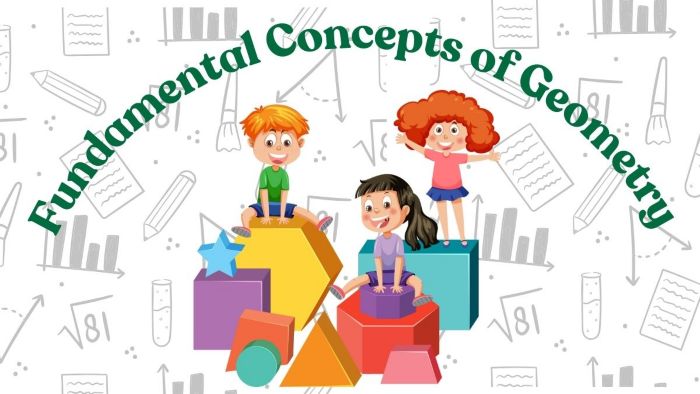Fundamental Concepts of Geometry - Basic Concepts
In this learning concept, the students will also learn to
-
Fundamental Concepts of Geometry
Each concept is explained to class 4 maths students using illustrations, examples, and mind maps. Students can assess their learning by solving the printable basic concepts of geometry worksheets given at the page’s end.
Download the basic concepts of geometry worksheets for class 4 and check the Basic geometry concepts questions provided in PDF format.
Introduction to Geometry
Geometry is the branch of mathematics that deals with shapes, sizes, and properties of space. In Grade 4, students started learning basic concepts of geometry, such as basic shapes, lines, and angles, and understanding relationships between them and their position in space. This textbook covers some of the most common fundamental geometric concepts.

Basic concepts
Points
The most basic unit in geometry, a point represents a location in space without any dimensions (length, width, or height). Points are usually labeled with capital letters (e.g.,
A, B, C).
Example: Think of points like stars in the night sky. Each star represents a unique spot in space, and although you can see where each star is, it has no size or shape from our perspective.
Line
A line is a set of points that extends in a straight path endlessly in both directions. A line has no fixed length and no endpoints.
For example, Imagine train tracks extending straight into the distance. The tracks go on and on, seemingly forever, just like a line in geometry that has no end

Types of Lines
Line Segment
A part of a line with two endpoints.
For Example: Picture a bridge between two cities, like the Golden Gate Bridge between San Francisco and Marin County. This bridge has a definite starting and ending point, making it similar to a line segment, which has two fixed endpoints.

Ray
A ray in geometry is part of a line which extends endlessly in one direction. It has one end point. A ray has no definite length.
Ray PQ with endpoint P can be extended endlessly beyond Q. The arrow head shows the direction in which a ray can be extended endlessly. Ray PQ is written as PQ.
For example, Imagine a flashlight in a dark room. When you turn it on, the light starts from the flashlight and extends outward in one direction indefinitely, much like a ray starting at an endpoint and going on infinitely.
Angles
An angle is formed by joining two rays, which have a common end point called the vertex.
Given below are angles that you see in daily life:
Naming of angle
The angle can be named in three different ways.
The given angle can be named ABC, CBA or B.
Activities to Reinforce Learning
-
Shape Hunt: Go on a “shape hunt” to find real-life examples of squares, rectangles, and circles around the classroom or home.
-
Angle Estimation: Use a protractor or estimate angles in everyday objects.
-
Symmetry Drawing: Fold a piece of paper in half and draw one side of a shape. Unfold it to see if both sides are symmetrical.
-
Perimeter Challenge: Measure and calculate the perimeter of objects (e.g., a desk or a book).
-
Coordinate Connect-the-Dots: Practice plotting points to make shapes or pictures on a grid.
Geometry Quiz
1. What is a point?
A) A line with length
B) A location with no size
C) A shape with edges
D) A curved line
2. What is a line segment?
A) A ray with one endpoint
B) A straight line that has no endpoints
C) A part of a line with two fixed endpoints
D) A curved path
3. Which of the following represents a line?
A) A pencil with two ends
B) A ray starting from a point
C) Train tracks that go on forever
D) A door hinge
4. What angle is formed when a book is opened at a 90° angle?
A) Acute angle
B) Right angle
C) Obtuse angle
D) Straight angle
5. Which of the following is an example of a ray?
A) The edge of a table
B) A beam of sunlight shining through a window
C) A closed circle
D) A straight path from one point to another
Learn more about the basics of shapes, lines, and angles in Fundamental Concepts of Geometry! from the video given below:
Practice Worksheets:
Click to download the worksheets for hands-on practice!
Easy Level Worksheets
Intermediate Level Worksheets
Advanced Level Worksheets
CBSE Schools In Popular Cities
- CBSE Schools in Bangalore
- CBSE Schools in Mumbai
- CBSE Schools in Pune
- CBSE Schools in Hyderabad
- CBSE Schools in Chennai
- CBSE Schools in Gurgaon
- CBSE Schools in Kolkata
- CBSE Schools in Indore
- CBSE Schools in Sonipat
- CBSE Schools in Delhi
- CBSE Schools in Rohtak
- CBSE Schools in Bhopal
- CBSE Schools in Aurangabad
- CBSE Schools in Jabalpur
- CBSE Schools in Jaipur
- CBSE Schools in Jodhpur
- CBSE Schools in Nagpur
- CBSE Schools in Ahmednagar
- CBSE School In Tumkur











